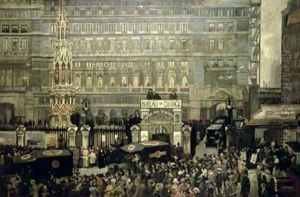J. Hodgson Lobley Paintings
J. Hodgson Lobley, born in 1864, was a distinguished British artist known for his prolific output in the field of etching and painting. Although not as widely recognized as some of his contemporaries, Lobley's work offers a fascinating glimpse into the artistic movements and sensibilities of his time, particularly the late 19th and early 20th centuries. His contributions to the art world, though more subtle in the grand narrative of art history, are nonetheless significant for their beauty, technique, and historical value.
Lobley's artistic journey was marked by a dedication to both the rural landscapes of Britain and the dynamic urban scenes, capturing the essence of his environment with a delicate balance between realism and romanticism. His etchings, in particular, showcase a meticulous attention to detail and a masterful control of line, contributing to the revival of interest in etching as a serious art form during the late 19th century. Through his work, Lobley engaged with the broader movements of his time, including the etching revival, which sought to elevate etching to the status of fine art, parallel to the more traditional mediums of painting and sculpture.
Throughout his career, J. Hodgson Lobley exhibited at various prestigious institutions, including the Royal Academy and the Royal Society of Painter-Etchers and Engravers, which played a pivotal role in promoting etchers and their work. His landscapes and urban scenes, characterized by their evocative atmosphere and intricate detail, earned him a place among the notable British artists of his era. Despite the fact that his name might not echo as loudly in the halls of art history as some of his peers, Lobley's work remains an important testament to the rich tapestry of British art at the turn of the century.
Lobley's death in 1954 marked the end of a long and productive career. Over the decades, he left behind a body of work that continues to be appreciated by art historians and collectors alike. His contributions to the field of etching and painting not only enrich our understanding of the period's artistic achievements but also offer a window into the cultural and aesthetic shifts of his time. Though specifics about his personal life and training are less documented than his professional achievements, Lobley's legacy is preserved in the quality and depth of his art, which stands as a tribute to his skill and vision.
